Counts of Celje
Last updated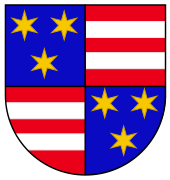
The Counts of Celje (Slovene : Celjski grofje) or the Counts of Cilli (German : Grafen von Cilli; Hungarian : cillei grófok) were the most influential late medieval noble dynasty on the territory of present-day Slovenia. Risen as vassals of the Habsburg dukes of Styria in the early 14th century, they ruled the County of Cilli as immediate counts ( Reichsgrafen ) from 1341 and rose to Princes of the Holy Roman Empire in 1436.
Contents
History

The Lords of Sanneck (Žovnek) Castle on the Sann (Savinja) river in Lower Styria were first mentioned around 1123/30. Their ancestors may have been relatives of Saint Hemma of Gurk (d. 1045), who held large estates in the area. The fortress was allegedly already built under the rule of Charlemagne as a stronghold against the Avars.
Counts
One Leopold of Sanneck appeared as a supporter of the Habsburg king Rudolf I of Germany in the 1278 Battle on the Marchfeld. In the early 14th century, the Lords of Sanneck allied with the Austrian Habsburgs in their conflict against Duke Henry VI of Carinthia around the Kingdom of Bohemia, making them Habsburg vassals in 1308. [1] Leopold's brother Frederick by marriage inherited the large possessions of the late Counts of Heunburg in 1322; the Celje estates became a property of the dynasty in 1333, [1] not before years of feuds with Count Ulrich V of Pfannberg and other rival noble dynasties. Frederick finally prevailed with the support of Otto the Merry, the Habsburg duke of Styria. He became governor of Carniola and the Windic March in 1332 and was elevated to comital status by Emperor Louis IV in 1341 at Munich, receiving the title Cylie or Cilli derived from Celje Castle.
The Counts of Celje soon owned more than 20 castles spread over the territory of modern Slovenia and beyond through the marriages of their daughters. By acquiring large estates in the adjoining duchies of Styria and Carinthia, in the March of Carniola as well as in the territories of the Hungarian Crown (including Croatia and Slavonia), their influence rose and they became one of the most powerful families in the area. Count Ulrich I of Cilli, a leader of mercenary soldiers, joined King Louis I of Hungary on his 1354 campaign into Dalmatia and, shortly afterwards, accompanied the Rex Romanorum Charles IV to his coronation at Rome. His son William married Anna of Poland, daughter of the Polish king Casimir III the Great. The Counts of Cilli were related by marriage with rulers of Bosnia and Polish and Hungarian kings. [2] Through Barbara of Cilli the Counts were also in kinship with the royalty of Bohemia.
Imperial princes
Their rapid rise continued after the 1396 Battle of Nicopolis against the Ottoman Empire, where Count Hermann II of Cilli saved the life of King Sigismund of Hungary, the son of the late Emperor Charles IV. As a reward, the king donated (1397–99) the city of Varaždin, the county of Zagorje, Međimurje region [3] and many estates in Croatia to the family. [1] In 1401, the Counts of Cilli were among Sigismund's supporters against the relucting[ clarification needed ] Hungarian magnates. Their alliance with the Imperial House of Luxembourg became even closer through the marriage of Hermann's daughter Barbara of Cilli to the king in 1405. [1] In 1418, Count Hermann II inherited the Carinthian and Carniolan estates of the extinct Counts of Ortenburg, which was subsequently administered by his vassal Andreas von Graben zu Sommeregg.
In 1410, Sigismund had been elected King of the Romans and was crowned Holy Roman Emperor in 1433. In 1436 he elevated the Counts of Cilli to the rank of Princes of the Holy Roman Empire (although they retained their title of Graf (Slovene : grof)). The Habsburgs, whose strongest rivals they had become, reacted with a war that lasted until 1443, when an agreement of mutual inheritance was signed. [2]
Count Ulrich II of Cilli was the most powerful member of the Cilli family. In 1432 he married Catherine, daughter of the Serbian despot Đurađ Branković. Ulrich held a large influence in many courts, which originated from the relationships the Cilli family had made in the past. Upon the death of the Habsburg king Albert II in 1439, he tried to get regency of Hungary, Bohemia and Austria through control over Albert's minor son Ladislaus the Posthumous. With such ambitions he got many opponents and rivals, such as the Hungarian Hunyadi family. After an unsuccessful claim to the Bosnian crown, Cilli obtained some territories in Croatia and Slavonia and in 1452 finally succeeded in forcing Emperor Frederick III to hand over the boy king Ladislaus to his keeping. Thus, Ulrich II became de facto regent of Hungary.
Decline
In 1456 after the death of his rival John Hunyadi, Ulrich II succeeded him as Captain General of Hungary. That initiated a plot by the Hunyadi family against Ulrich II, and he was assassinated by the men of John Hunyadi's son Ladislaus on 8 November in Belgrade.
With the death of Ulrich II the male line of the Counts of Cilli died out, and after a war of succession all of their estates and property were handed over to the Habsburgs on the basis of the inheritance agreement.
Legacy
Part of their coat of arms - the three golden stars on a blue background, which, as Lords of Sanneck, they had inherited from the once powerful Carinthian Counts of Heunburg in 1322 - was incorporated into the Emblem of Yugoslavia in 1920s and the Slovenian coat of arms in 1991. It is also the current coat of arms of Celje.
Lords of Sanneck or Barons of Soune, Counts of Cilli

The Lords of Sanneck (Žovnek) or Barons of Soune [2]
- Gebhard (c. 1130–1144)
- Gebhard II (1173–1227)
- Conrad I (died c. 1255)
- Ulrich I of Sanneck (died c. 1265)
- Ulrich II of Sanneck (died c. 1316), married Countess Catherine of Heunburg, heir to the count Ulrich II of Heunburg and her wife Agnes of Baden
- Frederick I (c. 1300–1359/60), son, from 1341 Count of Celje
Counts of Cilli (Celje) [2]
- Ulrich I (1331–1368), son of Frederick I, Captain in Carniola, married Countess Adelheid of Ortenburg
- Herman I (1332/34–1385), son of Frederick I, married Catherine, daughter of Ban Stephen II of Bosnia
- William (1361/62–1392), son of Ulrich I, married Anna of Poland, daughter of King Casimir III the Great of Poland
- Anna of Cilli (1380–1416), daughter, married King Władysław II Jagiełło of Poland
- Herman II (c. 1365–1435), son of Hermann I, Ban of Croatia and Dalmatia
- Barbara of Cilli (c. 1390–1451), daughter, married King Sigismund of Hungary
- Frederick II (died 1454), son of Hermann II, Prince in 1436, Ban of Slavonia, 1. wife Elizabeth of Frankopan, 2. wife Veronika of Desenice
- Ulrich II (1407–1456), son, married Catherine of Branković
- Kantakuzina Katarina Branković (1456–1458), widow of Ulrich.
In 1458 the county is annexed to Austria.
See also
Related Research Articles

Ladislaus V, more commonly known as Ladislausthe Posthumous, was Duke of Austria and King of Hungary, Croatia and Bohemia. He was the posthumous son of Albert of Habsburg with Elizabeth of Luxembourg. Albert had bequeathed all his realms to his future son on his deathbed, but only the estates of Austria accepted his last will. Fearing an Ottoman invasion, the majority of the Hungarian lords and prelates offered the crown to Vladislaus III of Poland. The Hussite noblemen and towns of Bohemia did not acknowledge the hereditary right of Albert's descendants to the throne, but also did not elect a new king.

John Hunyadi was a leading Hungarian military and political figure in Central and Southeastern Europe during the 15th century. According to most contemporary sources, he was the member of a noble family of Wallachian ancestry. He mastered his military skills on the southern borderlands of the Kingdom of Hungary that were exposed to Ottoman attacks. Appointed voivode of Transylvania and head of a number of southern counties, he assumed responsibility for the defense of the frontiers in 1441.

Hermann II, Count of Celje, was a Styrian prince and magnate, most notable as the faithful supporter and father-in-law of the Hungarian king and Holy Roman Emperor Sigismund of Luxembourg. Hermann's loyalty to the King ensured him generous grants of land and privileges that led him to become the greatest landowner in Slavonia. He served as governor of Carniola, and twice as ban of the combined provinces of Slavonia, Croatia and Dalmatia, and was recognized by a treaty in 1427 as heir presumptive to the Kingdom of Bosnia. The House of Celje's rise to power culminated in achieving the dignity of Prince of the Holy Roman Empire. At the peak of his power, he controlled two thirds of the land in Carniola, most of Lower Styria, and exercised power over all of medieval Croatia. Hermann was one of the most important representatives of the House of Celje, having brought the dynasty from regional importance to the foreground of Central European politics.

Đurađ Branković was the Serbian Despot from 1427 to 1456. He was one of the last Serbian medieval rulers. He was a participant in the battle of Ankara (1402) and Ottoman Interregnum (1403-1413). During his reign, the despotate was a vassal of both Ottoman sultans as well as Hungarian kings. Despot George was neutral during the Polish-Lithuanian (1444) and Hungarian-Wallachian (1448) crusades. In 1455, he was wounded and imprisoned during clashes with the Hungarians, after which the young Sultan Mehmed II launched the siege of Belgrade and its large Hungarian garrison. Despot Đurađ died at the end of 1456, due to complications stemming from the wound. After his death, Serbia, Bosnia and Albania became practically annexed by sultan Mehmed II, which only ended after centuries of additional conquests of Byzantine lands. Đurađ attained a large library of Serbian, Slavonic, Latin, and Greek manuscripts. He made his capital Smederevo a centre of Serbian culture. He was the first of the Branković dynasty to hold the Serbian monarchy.

Nicola Frangipani in croatian language Nikola IV Frankopan was a Croatian nobleman and the Ban of Croatia and Dalmatia from 1426 to 1432.

Ulrich II, or Ulrich of Celje, was the last Princely Count of Celje. At the time of his death, he was captain general and de facto regent of Hungary, ban (governor) of Slavonia, Croatia and Dalmatia and feudal lord of vast areas in present-day Slovenia, Croatia, Bosnia, Austria, and Slovakia. He was also a claimant to the Bosnian throne. He was killed by agents of the Hunyadi clan under unknown circumstances, which plunged Hungary into civil unrest that was resolved a year later by the sudden death of king Ladislas the Posthumous and the election of Matthias Corvinus, the son of John Hunyadi and Ulrich's son-in-law, as king. Ulrich's possessions in the Holy Roman Empire were inherited by Emperor Frederick III, while his possessions in Hungary were reverted to the crown.

The Counts of Ortenburg were a comital family in the mediaeval Duchy of Carinthia. Though they had roots in Bavarian nobility, an affiliation with the Imperial Counts of Ortenburg, a branch line of the Rhenish Franconian House of Sponheim, is not established.

Nicholas II Garai was a powerful Hungarian baron who served as the Palatine of Hungary from 1402 until 1433 and the ban of Macsó, Usora, Só, Slavonia, Croatia and Dalmatia. He also ruled over the Braničevo, Syrmia, Bačka, Banat and Baranya regions through vassals. Together with his close ally Stibor of Stiboricz, he remained one of the richest and most powerful nobles in Hungary for over 30 years. Nicholas II Garai also served as de facto ruler of Hungary next to King Sigismund. In 1416 Sigismund extended their armorial bearings showing the Order of the Dragon and the Order of the Scarf. He presented the patent to his brother-in-law.
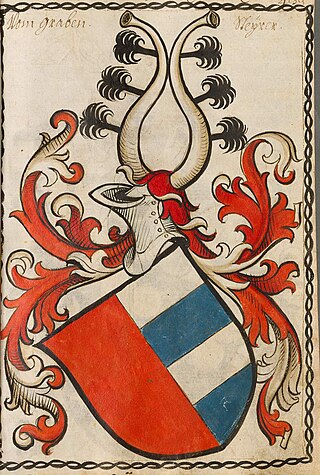
Andreas von Graben zu Sommeregg was a Carinthian knight and nobleman residing at Sommeregg Castle. He served as a burgrave and castellan governor in the Ortenburg estates, held by the Counts of Celje until 1456. With the extinction of the Cillier family, Von Graben lost the post of captain of the County of Ortenburg under the Habsburgs, their successors as Ortenburg sovereign.
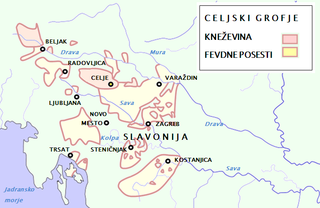
The County of Cilli was a Medieval county in the territory of the present-day Slovenia. It was governed by the Counts of Cilli.

John II of Gorizia was the penultimate Count of Gorizia. He ruled the County of Gorizia from 1454 until his death.
Elizabeth of Celje, also Elizabeth of Cilli, was the first wife of Matthias Corvinus, the future King of Hungary.

Agnes of Baden, was a German noblewoman by birth member of the House of Baden and by her two marriages Duchess of Carinthia and Countess of Heunburg.

The Mark an der Sann was a border march of the Holy Roman Empire, in the territory of present-day Slovenia. It was established in the second half of the 10th century to protect the Empire against its enemies to the east, especially from Hungarian raids.
Hermann I, Count of Celje, was a Styrian nobleman, who was head of the House of Celje between 1359 and 1385. In the first decade, he ruled together with his older brother Ulrich. After Ulrich's death, Hermann took over the custody of his nephew William and ruled as the de facto head of the family. Under his rule, the House of Celje began expanding its influence from its power base in present-day Slovenia and southern Carinthia to Central Europe and the Balkans. By marriage to the Bosnian princess Catherine, whose exact parentage is disputed, Hermann became the brother-in-law either of the Hungarian and Polish king Louis the Great, or of the Bosnian king Tvrtko I. His son Hermann II further expanded the family's wealth and influence. By the time of his death, Hermann I was the largest landowner in the territory of present-day Slovenia, where his possessions significantly outnumbered those of his Habsburg liege lords.

Frederick I of Celje also Frederick I of Cilli, was a Styrian free noble who became the first Count of Celje, founding a noble house that would dominate Slovenian and Croatian history in the first half of the 15th century.
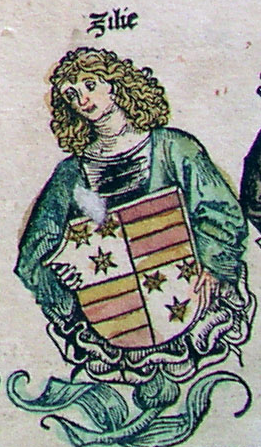
Ulrich I, Count of Celje, was a Styrian nobleman and condottiere, who was head of the House of Celje between 1359 and 1368, together with his younger brother Hermann I. During his reign, the House of Celje became one of the most powerful noble houses in the territory of present-day Slovenia, and laid the basis for its expansion to neighboring Slavonia and Croatia in the next generation. Ulrich's skills as a military commander are usually credited for the House of Celje's acceptance into the circles of the Central European high nobility in the second half of the 14th century. His life was immortalized in the poem Von graff Ulrichen von Tzili by the 14th century Austrian poet Peter Suchenwirt.
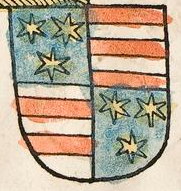
William of Celje, also William of Cilli, Count of Celje, was a Styrian nobleman who was married to Anna of Poland, daughter of the Polish king Casimir the Great. He was the co-ruler of the House of Celje together with his uncle Hermann I until 1385 and then with his cousin Hermann II until his death. William's only daughter, Anna of Celje, married the Polish King Vladislav II Jagello in order to strengthen his claim to the Polish throne.

Ulrich of Sanneck, Lord of Žovnek, was a free noble in the March of Savinja in what was then the Holy Roman Empire and is now in Slovenia. During the struggle between Henry, Duke of Carinthia and the Habsburg rulers of Austria and Styria, he sided with the latter. By accepting the Habsburgs as his liege lords, he was instrumental in transferring the lordship over the Savinja region from the Meinhardiner-dominated Carniola to Habsburg Styria. His second marriage with the noblewoman Catherine of Heunburg would enable their son to claim the Heunburg inheritance in Carinthia and in the Savinja Valley, including the strategically important Celje Castle. This union of the Sanneck (Žovnek) and Heunburg (Vovbre) noble houses would give birth to the House of Celje.

The House of Talovac was a Croatian noble family, descending from the island of Korčula and reaching its peak in the 15th century in the Kingdom of Croatia, at that time in personal union with Hungary. The members of the family rose to high state, church or military offices, such as Ban (Viceroy) of Croatia and Dalmatia as well as Ban of Whole Slavonia, royal court chamberlain, bishop, župan and others.